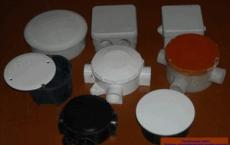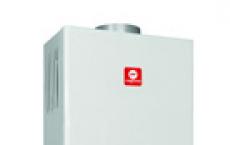How to connect the outlet from the junction box. Why you need a junction box for electrical wiring
Installation of electrical wiring in the house, apartment, garage, office, etc., is always performed with the installation of distribution boxes. One minimum is always installed in each room.
From the branch boxes, electrical cables or wires to the lamps, switches and outlets disagree. They consist of a plastic housing with a cover, can be built in for concealed wiring (in Figures 3 and 4) and overheads for outdoor (in Figures 1 and 2).
Metal distribution boxes are subject to mandatory grounding and are installed only when laying electrical cables in metal pipes. For example, in wooden houses and buildings according to rules and requirements.
The junction boxes differ in size and shape. Large boxes should be used in places where a large number of cables or wires will come. In shape, it is better to take a round than a square or rectangular, because it will not be necessary to level them. And you can use a bit to drill a hole in the plasterboard, blocks, bricks, etc.
Before proceeding with the installation of the box it is necessary to make shtroby and fix the cables in them from the place of its installation to the sockets, switches and lamps. Or fix the cables behind the plasterboard or the panels that cover the walls or ceiling.
With open wiring the mounting box is fixed to the ceiling or wall with 2 self-tapping screws or dowels, only wind the electrical cables through special seals.  In the gaskets, it is necessary to cut the hole slightly less than the diameter of the cable. The figure shows an option with dustproof seals. There are waterproof versions with rubber seals and threaded plugs.
In the gaskets, it is necessary to cut the hole slightly less than the diameter of the cable. The figure shows an option with dustproof seals. There are waterproof versions with rubber seals and threaded plugs.
For installation of a built-in box it is necessary to knock out or drill a cavity, into which it is then necessary to insert the box flush. It's much easier to put a box in a drywall.
Installation of a junction box in a drywall.
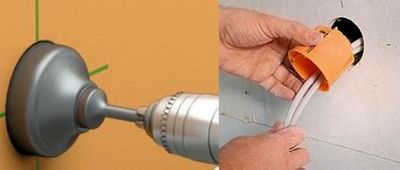
After that, clean the wires and connect them over this one.
How to install a junction box for concealed wiring.
In houses and apartments all wiring is hidden under the plaster or in the channels of panel houses, so the junction box hides flush with the walls. For her installation is necessary:
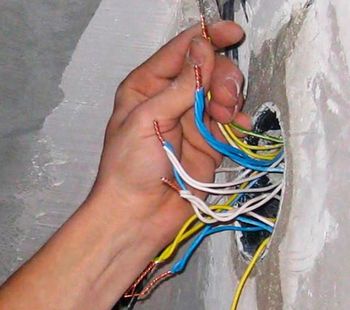
When it is not rounded boxes should be watched so that it would be fixed exactly in level. Especially it concerns rectangular variants. Square boxes, even if they are crooked, in most cases allow the lid to be leveled.
In order to ensure a reliable and even distribution of electrical energy in urban and private homes, the wiring is divided into several groups, for which a separate supply wire is laid in each room, to which all the wiring of the room, such as: lighting, switches, plug sockets and others. One of the most common methods of switching branches is the use of a distribution (branching) box. It is a body made of plastic or metal, with holes for cable entry, in which the wires are connected to each other and converge at one point according to the specified wiring diagram of the room. Outside, the branching box is closed with a lid. The cover can have a rubber ring ensuring tightness of the connection to the housing, fastened on the screws or snap into the grooves of the box body.
Types
Depending on the method of laying the electrical wiring of the premises, the distribution boxes are divided into:
- twist;
- connection by means of terminals integrated in the junction box;
- self-isolating clamps (PPE);
- crimping (twisting of wires is placed inside a copper sleeve, crimped with a special press);
- welding or soldering.
During wiring work, wire connections should not be misused, since no crimping or welding can be more reliable than a complete cable. A large number of switching nodes increases the likelihood of wiring faults, in addition, junction boxes must be publicly available for repair, which is difficult for a large number of them, so install the boxes wherever they are really needed. At the same time, the desire to reduce the number of junction boxes leads to a significant expenditure of cable, so when planning the work, it is necessary to find a balance between these factors.
An example of the optimal arrangement of junction boxes is shown in the picture below.
Security rules for installation
The connection of wires inside the box must be carried out in strict accordance with the electrical scheme of the premises, otherwise accidents in the power grid are inevitable. To avoid errors when connecting wires, it is recommended to sign each end of the wire coming out of the junction box. Each group of wires connected in a junction box should be signed separately. When using boxes with a metal casing, it must be grounded.
The picture above shows the layout of the junction boxes in a three-room apartment with a recording studio equipped with it. In the hall there is an input distribution box 1. In room 3 there are two junction boxes 5 and 6 located one after another. In box 6, the wires of switches and sockets are connected in the area of the room assigned to the recording studio.
To some, the junction box for electrical wiring will appear to be a very small element of the household electrical network. And really, what's the use of it? With the help of the switch we control the lighting, the sockets are powered by electrical appliances and equipment - from these elements of the electrical network there is a visible total. And an invisible, but very important result, is that switches, sockets and lamps are connected to a common electrical network through junction boxes. It is in them that the wires coming from the power source and going to the switching devices are connected.
History of appearance
As soon as the first node was assembled, in which several wires of the branched electrical network were connected, there immediately appeared a need for its protection. First of all, from casual touches of the person to the bare wire that could lead to a defeat by an electric current. It also required protection from external influences - mechanical, dust, dirt, water.
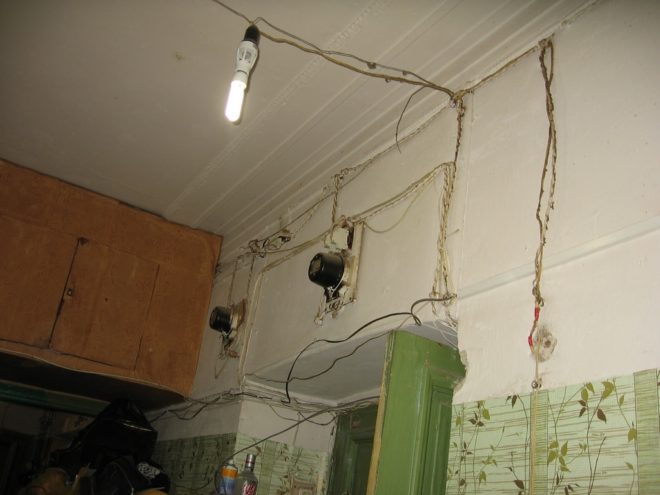
Even during the first steps of electrification, it was invented to protect the place of wire twisting by a box. First, for this purpose in the course went to improvised funds, for example, cans from canned food. In them, holes were made, into which wires were inserted and twisted together. The most important thing was to carefully cut the holes, make their edges even and not jagged, so as not to damage the insulation of the wires.
However, very soon the electrotechnical evolution led to a mass production by manufacturers of the necessary factory distribution boxes. Although now, after almost a century, somewhere and there is a craftsman who in the garage or in the shed will make the connection of wires in a tin can.
Well, if you build a house or do major repairs in an apartment, you must start with electrical work. The first thing to do is install the junction boxes, do not use any cans and improvised tools, even in the back rooms. Go to the market of electrical goods, there boxes are sold in abundance - any size, configuration and degree of protection.
Why is it called differently?
The electrical connecting box received several names at once - distributive, soldering, tapping, and tripping.
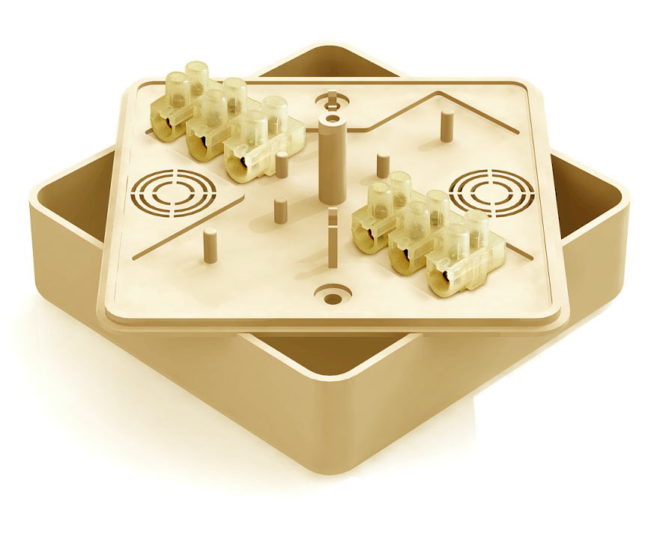
It is like an electrical distribution point, where voltage from the power source comes in, and then diverges along several electric branches - to outlets, switches, lighting devices. For the fact that in the box voltage is distributed in different directions, it is called distribution. As several electric branches leave the box, a synonym - an offshoot - appeared.
Another name comes from the way the wires are connected inside the box. For a long time, soldering was considered the most reliable method. At the junction of the wire twisted, and then soldered, due to which the electricians began to call the boxes uncoordinated.
Interestingly, there was another synonym - a box of exclusives. The word "disconnection" can be heard only among professional electricians, and came up with it, as if combining two concepts - distribution and connection. That is distributed in the box, which wire and where should go, and then connected them according to the scheme.
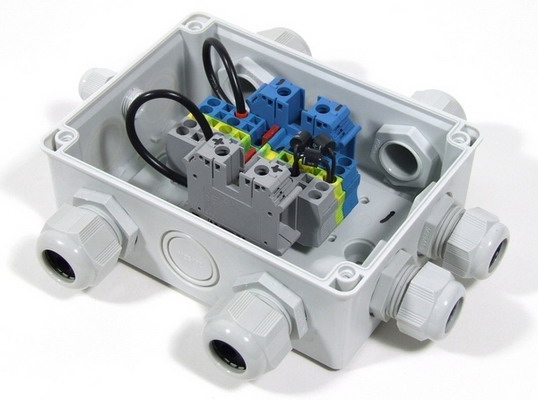
Now there are so many modern connection options - all kinds of terminals, welding, connecting insulating clamps, using crimping, terminal blocks, self-clamping terminals. However, the boxes are still often referred to as the case.
All this we explained to you so that when you go to choose materials in electrical stores, and in different places you will see different names, you know, they all mean the same junction box.
Is it always necessary?
Quite a logical question, can you do without a junction box? Purely, yes.
And now imagine that from the lead-in electrical panel, which is usually located at the entrance to the house or apartment, it will be necessary to stretch a separate line for each switch and outlet. This is how much wire is needed then? And the strobes will have to be wide and deep, so that you can put a few wires in them. So, purely from the economic point of view, the installation of distribution boxes is a rational and expedient solution.

Someone can argue and say that it is much safer to build a whole line from an electric flap to a switch or socket, and in the box there will be only an extra junction. To this one is the answer - correctly and correctly made connection of wires does not present any danger.
Everyone can have their own opinion about this, however, to date, the option using junction boxes is the most preferable.
Kinds
Boxes for connecting electrical wires are of different types and are classified according to many parameters.
By the method of installation
First of all, they are divided according to the installation method:
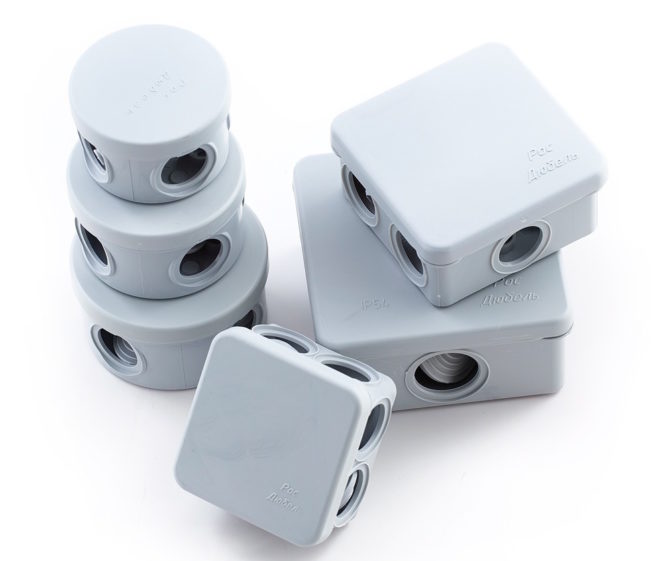
By material
The boxes differ depending on the material from which they are made. First of all, it should be such materials that would ensure the maximum protection for the connected wires for the entire lifetime. In this regard, the boxes for electrical wiring are made of high-quality plastic and metals, which are still coated with a protective layer of anticorrosive paint or primer.

For the production of metal boxes, use sheet metal or aluminum alloys that are not corroded. If a fire occurs, the metal case will for some time serve as a protection for the contents of the box, during this time at least it will be possible to de-energize the electrical network. Metal boxes are used most often in general purpose buildings (garages, utility rooms, sheds).
With no less efficiency will protect electrical connections and plastic junction box. For their manufacture, polyamide, polypropylene or cast PTFE is used, these materials are not subject to decomposition by active substances. Such plastic boxes serve as excellent insulation against electric shock. In addition to good insulation properties, they also have sufficient mechanical strength. The plastic soldering box is resistant to aggressive chemical fluids and can be kept in a humid environment much longer than a metal one. If there is a danger of open fire, the plastic does not burn, but melts, in this, of course, it is inferior to the metal.
Other parameters
Distribution boxes vary in size and here the following criteria play the main role:
- their appointment;
- number of inputs;
- protection class.
The minimum in the box can be two inputs, that is, two wires will be connected in it. The maximum number of inputs in one junction box is 16. Accordingly, the more entries, the larger the box in size and depth.

The boxes differ in shape, can be round, square and rectangular. For outdoor installation there is no difference at all what shape you will use the box. But for an internal installation it's better to take a round one, because if you have a concrete wall, it is much easier to make a hole in it than to hollow a square niche.
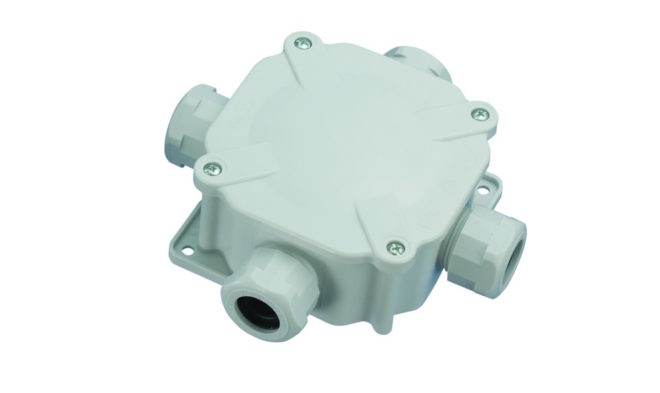
Of all the above criteria, the price of the junction box is added. The price is also affected by the degree of protection of this element:
- IP 20, IP 30 - for operation only in dry rooms, moisture protection is not available;
- IP 44 - for use outdoors and in rooms with high humidity, when installing outdoors, you must choose a place under the visor or canopy, as well as avoid direct exposure to dust and water spray;
- IP 55 - for operation in places subject to atmospheric precipitation, that is, boxes with such a degree of protection can be installed outdoors under any conditions, they are completely protected from dust and water spray;
- IP 67 - for outdoor use in any atmospheric precipitation, as well as on land and in the ground;
- IP 68 - boxes with this degree of protection can be operated with immersion in water, as a rule, the depth of immersion is additionally indicated for each product on the package or body.
For household electricity mains most often used boxes with a degree of protection IP 55.
Installation rules

Before installing the junction box, familiarize yourself with the requirements prescribed in the main normative document of the electricians of the PUE, as well as with useful advice on the installation of junction boxes:
- Install the box at a distance of 10-30 cm below the ceiling.
- There must always be access to the junction box. There are cases when it was installed at the right distance from the ceiling, but then during the new repair and installation of tension or suspended ceilings, the box was out of the access (that is, the ceiling level dropped). There is an option, leave a small hatch in the new ceiling for easy access to the box. But, most likely, it will not have a quite eye-catching and aesthetic appearance. It is best before moving to a new location before making new ceilings.
- With the hidden version of the wiring in the wall, a recess is made for each junction box according to its size and shape (round or square). The depth of the niche is such that the box then does not stick out of the wall, and the lid in a closed form turned flush with the wall surface.
- Outdoor models of boxes are mounted already on the prepared decorated walls.
- If the room is made of quality repair, then I would not want to spoil its appearance with an unsightly lid closing the junction box. In this case, either decorate the cover for your interior design (paste the wallpaper or color it in the tone), or in advance choose a box with a decorative cover.
- In the event that you have pasted a box with wallpaper, be sure to remember the location of its location, if necessary, cut off the wallpaper on the spot and get access to the places of wire connections. It is best to keep a home electrician's logbook, which will draw all the points of the boxes and the route of the wires in the stitches. This is very convenient also if you need to drill a wall for a picture or a photo frame. Knowing the schematic layout of the wiring, you definitely will not stumble on it with an electric drill.
- In the junction box you need to look not only when it is already puffed from the smoke. Periodically, it is necessary to check the connections for their heating, and also pull the contacts.
Installation
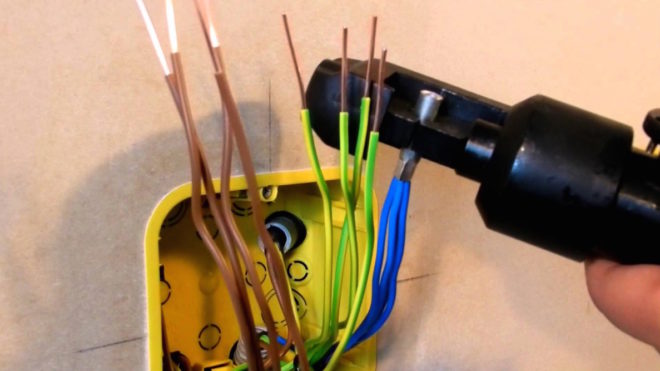
To install the box in the wall, you must first prepare the hole. You will need a special tool, the best is a perforator with a special nozzle called a crown. What does it represent? A ring with a cutting or diamond edge. In the center there is a drill intended for concrete, it centers the crown, and already it cuts the round segment out of the wall. The required depth is drilled, then the cut out segment is removed from the wall using a chisel and a hammer (you can use a special blade, which is installed on the puncher). In the same way, a deep niche is made for each installed element of the power grid (sockets, switches).
Then from the hole it is necessary to pierce the shtroby, in which the wires or cables are laid. Their ends must be brought into the box (it has a few special holes for this) and leave sticking out for 10-15 cm to mount the connection.
Then the boxes are smeared into a niche on a solution of alabaster or building gypsum. It remains only to make all necessary wiring disconnections and close the installed element with a cover. Wires are connected by welding, twisting and subsequent soldering, crimping by sleeves or terminal blocks.
Now you know almost everything about junction boxes. Start your electricity supply repair always with them. To acquire these elements of the power grid is not a problem now, the main thing is to determine exactly which ones you need?
Probably, it is not necessary to say that the junction boxes for the electrical wiring of buildings are an integral part of the electrical scheme. And still, it will be superfluous to remind once again that electrical junction boxes are special plastic containers that have a rectangular or circular shape and are closed with a lid of the same plastic. Their main purpose - switching, that is, connecting, sections (loops) of electrical wiring in one place.
It is clear that electricity to consumers is brought through the wires that connect them to the switchboard. At the same time, the main requirement for wiring is the uniform distribution of current by consumers, and accordingly also by sections. Therefore, in each room there are several sections that feed the group or individual consumers of electricity. And since there are several sites, it means that they must necessarily connect somewhere. It is in this place and the junction box is installed. It is in them that the connection of the wires is made.
But experts say that this is not the main purpose of electrical distribution boxes. At the heart of their installation lies, as it is not strange, fire safety of operation of the electrical circuit of the building, and accordingly the entire structure itself. It should be noted that the connection of wires in the entire wiring is considered the most unreliable place. Often, twists are heated, burned insulation, which sometimes leads to fires and fires. So the junction box is a kind of protective barrier that provides fire safety requirements. Well, plus a secondary function, which is also important, this is the aesthetic side of the matter. Let's say straight, open twist or terminal elements on the wall - an unpresentable appearance.
As for the typical series of junction boxes, there are only two:
- Internal, used for internal wiring. Such an electrical junction box is installed in the wall, only its cover is visible from the outside.
- Overhead. Such devices are mounted over the wall and used for open wiring.
Do I need a junction box
Is it possible to not install junction boxes? If purely theoretically, then there are no problems. However, it is necessary to strengthen isolation of joints, especially it concerns those walls which are exposed to plastering. Or use a scheme to connect consumers, so to speak, a separate type. This is when each device is fed a separate wire from the switchboard. Imagine how much it takes for this wire, plus the increased amount of electrical work. In addition, it is necessary to lay wide enough and deep strobes so that a whole bunch of different-sized wires can fit in them.

Of course, you can put forward a counterargument and say that laying wires to each consumer is considered the safest. After all, this is the complete absence of connections. In principle, so it is. But if all the connections were conducted professionally, that is, in accordance with the norms and requirements, then their presence is not a danger. Although everyone decides for himself - to install a junction box or not.
Requirements for the installation of junction boxes
Let's consider what requirements are imposed on the installation of junction boxes, as well as the place of their installation.
- The height of installation of the device is 10-30 cm from the base surface of the ceiling. The exact size determines the height of the ceilings themselves.
- If the inside of the building uses a wired layout, then under each box is a niche for its size and shape. In this case, the installation depth must be such that the cover of the device is flush with the finished wall surface.
- If you use an invoice model, then it is installed directly on the already prepared decorated wall.
- A very important point, which is indicated in the PUE, is a free approach to the installation site of the junction box for maintenance and repair.
- No less important point, and, more precisely, the most important, is the knowledge of where the junction box of the concealed installation is located.
- Do not forget about the aesthetic side of the matter. Therefore, the cover of the box is sealed under the general design of the room or the device is selected with a decorative cover.
- In the event that the installation location of the distribution plastic device is under a tension or suspended ceiling structure, it is necessary to leave a hatch in the latter for easy access to the cover of the device.

How to correctly connect the wires in the junction box
Let's turn to the PUE, where the requirements for connecting wires in junction boxes are clearly spelled out. Here are a few options:
- soldering;
- crimping;
- terminals;
- with a screw or screw connection.
Which of these options is considered the best? If you take into account the two indicators: reliability and manufacturability, then the ideal option is twisting and subsequent soldering of the ends. You can use only twisting, and this is also a very technological option, although it has a lower reliability compared to soldering.
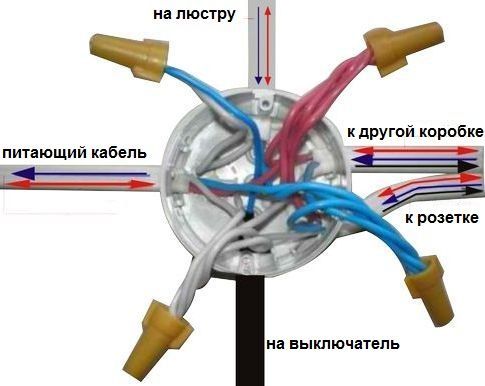
Now the connected ends of the wires must necessarily be insulated, for which an electrical tape is used. In this case, all connections must be installed in the junction box in such a way that they are distributed evenly throughout the interior of the device and do not touch each other.
Experienced electricians carry out an inspection of all connections after installation works. They connect a load to each circuit and check if any joint is heated. If the connection of the wires has become warm, it means that the area of their contact is small or the contact is loose. Therefore, this joint must necessarily be remade.
Similar entries: 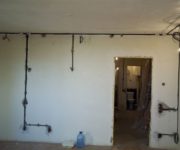
The junction box performs the function of a "switchboard" for the electrical wiring in the apartment, where wires from one supply cable run to "electrical points" (lighting devices and sockets).
Skilful use of boxes reduces the cost of laying electrical wiring many times.
 Types of junction boxes for electrical wiring are divided by type of installation, examples on the photo are next:
Types of junction boxes for electrical wiring are divided by type of installation, examples on the photo are next:
- open - mounted on the surface of walls and ceiling, used for open electrical wiring;
- hidden - installed in the recesses, specially made in the walls for the size of the box when installing a hidden wiring.
The main task of the box is to provide the electrician access to the ends of the wires that are connected to the common power supply circuit. Therefore, the junction box has a removable cover that not only protects, but also decorates the switching point.
Material for corkscrews
The junction box is made of materials that can provide maximum protection for the entire life of the wiring. For the cases used high-quality plastics and metals, protected by anticorrosive primers and paints.
Metal distribution boxes for electrical wiring are made of tinned steel sheet. Also, the boxes for the wiring of production electrical networks are made of aluminum alloys that are not susceptible to corrosion.
A massive body with a screw cap, waterproofing gaskets and sealed inlets has the highest protection category and provides protection from water (with immersion to a depth of up to 1 m), from dust and gases.
In case of fire, the metal case will protect the contents of the box for a while. During this time, you can disconnect the electrical wiring.
Plastic enclosure can provide no less effective protection. The cast PTFE or polypropylene is not decomposed by active substances, it isolates perfectly from electric shock and is able to spend more time in a moist environment than any metal.
In the defeat of open fire, plastics do not burn, but they can "swim". On the strength of plastic inferior to metal, but the junction boxes in the home are rarely exposed to shock loads.
Device
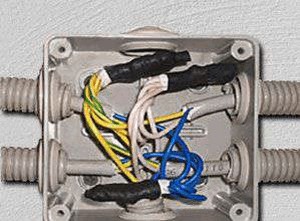 Inside the junction box is equipped with fasteners for the wires: terminal blocks and clamps. In the clamp, you can fix a thick cable (lead-in), and fasten the divided wires in the terminal block to the screw-fastening screws-clamps.
Inside the junction box is equipped with fasteners for the wires: terminal blocks and clamps. In the clamp, you can fix a thick cable (lead-in), and fasten the divided wires in the terminal block to the screw-fastening screws-clamps.
If there are no terminal blocks in the box, the electrical wiring in the junction box is "twisted": the divided ends of the wires are carefully twisted and insulated with plastic caps or insulation tape, then welded or crimped. But the terminals are much more convenient: you can connect wires of different cross-sections (for example, common input and wiring to individual points).
The only drawback of the terminal connection is that the bolted connection can weaken over time, and the wire contact is broken. Further, the joints begin to heat up, which leads to burning and failure of the connection. Therefore, the twist connection is the most reliable one.
It is impossible to connect wires from different metals, as the connection site is very quickly destroyed by the electrochemical process. If to say it is easier, because of oxidation, when connecting copper and aluminum, the resistance between the wires increases and the work of the power network is disrupted.
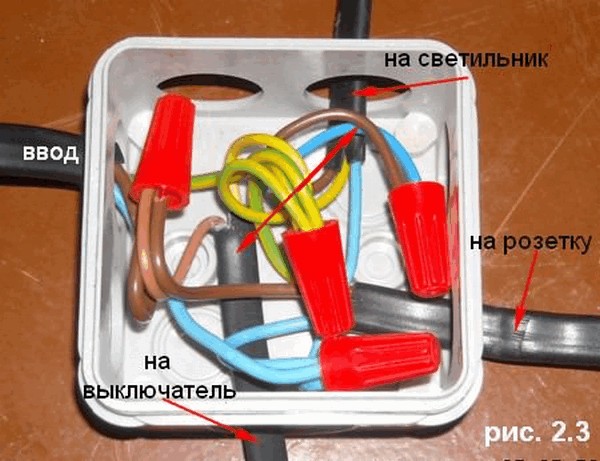
The socket with brass terminals does not undergo electroerosion and connects aluminum and copper wires without damage and for a long time. In housing construction, aluminum wires are rarely used, so pads are often equipped with copper conductors.
Pads are cast from plastics (polyethylene, polyamide, polypropylene) or from urea. Spring-loaded contacts made of copper or brass with rounded clamps tightly hold the wires. It does not require special efforts to screw the screws in the terminals (on the contrary, the accuracy will ensure a longer operation).
Holes in the casing of the junction box, intended for the input of wires or pipes, are provided with special glands. Tightly adhering to the surface of pipes rubber sealing rings prevent the ingress of water vapor and dust into the housing.
Dimensions
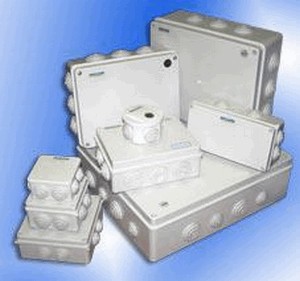 The dimensions of the junction box for electrical wiring depend on the number of inputs, the protection class and the assignment. A conventional apartment box for outdoor installation has dimensions from 10 cm in diameter or on the side of the square.
The dimensions of the junction box for electrical wiring depend on the number of inputs, the protection class and the assignment. A conventional apartment box for outdoor installation has dimensions from 10 cm in diameter or on the side of the square.
In the case of two to four holes, plugged with plastic or rubber stoppers. Overhead boxes are provided with holes or ears for screws to fix to the surfaces of premises.
The flush box is almost identical to the previous one, but all the holes for fixing are inside the case.
Junction box mounting
 When installing concealed wiring in brick and concrete walls, all elements (junction boxes, switches, sockets and wires) are laid in specially made in the surface of the walls and ceilings of the recess.
When installing concealed wiring in brick and concrete walls, all elements (junction boxes, switches, sockets and wires) are laid in specially made in the surface of the walls and ceilings of the recess.
Deepening under the box is arranged with a perforator and, if the box has a round shape, a special nozzle - crowns for work on concrete. In the "nest" box is fixed with alabaster solution or dowel-nail in the drilled hole.
The wiring in the junction box is connected according to the wiring diagram. The wires are put into the box through the holes with a margin of 10-15 cm. The ends of the wires are released from the insulation and fixed in the terminals of the shoe. If there are no pads, the wires are connected to twist. Connections are carefully insulated with electrical tape or plastic caps.
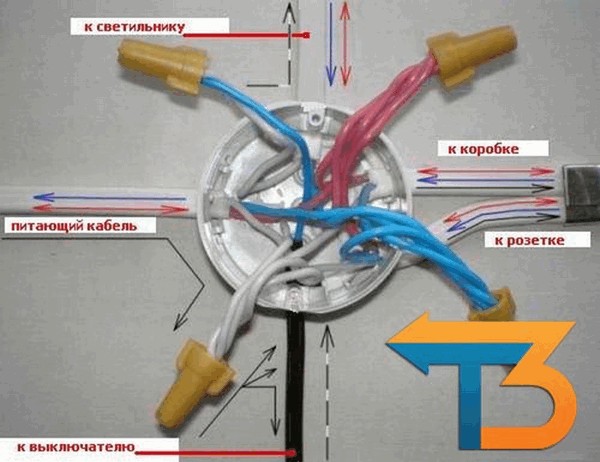
In frame structures for boxes special mounting places are prepared. The socket under the box is arranged in such a way that the body protrudes over the skin for 2-3 mm (to fix the lid).
Often the wiring is mounted in metal or plastic pipes. The dimensions of the holes allow the pipes to be connected to the box, and the tight glands or seal sleeves provide complete insulation from the external environment.
Distribution boxes are sold from electrical stores. The instructions describe the operating conditions, the degree of protection and the ratings of the voltage and amperage. Terminal blocks are either supplied separately or separately (an expanded series of terminals or a connection of solid and stranded wires).
The connection of wires in the switch box can be found in this video


